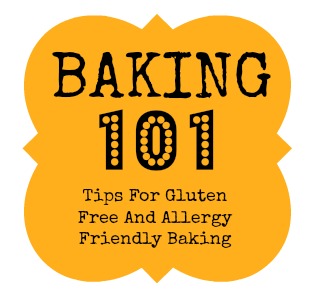The following post first appeared at Living Without Magazine’s blog entitled My Life With Food Allergies where I am a contributor.
When someone first learns of a food allergy or intolerance, one is often faced with the daunting task of learning to cook, bake and eat a whole new way. It is almost like learning a whole new language. Here is a list of 15 tips for baking gluten free and allergy friendly.
- Store your gluten free flours, starches and xanthan/guar gum in the freezer or refrigerator. This extends the shelf life of the product and the flours will not turn rancid.
- When getting ready to bake with gluten free flours let them sit on the counter and warm up a bit before baking with them.
- Do not omit the xanthan/guar gum. You will have a crumbly, disappointing mess if you do.
- When measuring gluten free flours always spoon your flours into the measuring cup and then level off. Unless the recipe specifically states, you do not want to “pack” the flour in the measuring cup.
- For baked goods such as “lightly” flavored cakes, cookies and so on, it is best to use a blend that contains brown rice flour and any combination of two starches.
- For baked goods that are heavily flavored with chocolate or molasses etc. it is fine to use a flour blend that contains a bean flour such as gar-fava.
- A gluten free blend that does not contain xanthan/ guar gum works better in my opinion, although this really comes down to personal preference. I like to add my own.
- Always use parchment paper when baking gluten free cookies. This prevents burning or uneven browning.
- Several different foods can be used to replace eggs. Applesauce and Ener-G Egg Replacer are favorites of mine. Others are flax meal mixed with water and tofu. Follow recipe directions in regards to the egg replacer choice. Recipe developers have various reasons for using the egg replacer they have chosen.
- Milk in baked goods can be replaced cup for cup regardless of the non-dairy milk you choose. Any of the non-dairy milks will work, but I like rice milk in baking.
- To make buttermilk use lemon juice or white vinegar. One Tablespoon plus enough milk to make one cup is the standard procedure.
- Always read the recipe all the way through before beginning your baking project. Do not make modifications unless you are really adept at doing so.
- When baking without eggs, always place the baked good in a preheated oven right away. Do not let the batter sit on the counter.
- Always use a timer.
- Butter in baked good recipes can often be replaced with shortening (palm oil or soy), or other dairy free alternatives now available in stores like Whole Foods.
Follow these tips and use good recipes and you will have delicious gluten free, allergy friendly baked goods.
Also shared at Allergy Free Wednesday. Gluten Free Tuesday.
